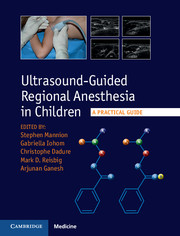Book contents
- Frontmatter
- Contents
- List of contributors
- 1 Introduction
- Section 1 Principles and practice
- Section 2 Upper limb
- Section 3 Lower limb
- Section 4 Truncal blocks
- Section 5 Neuraxial blocks
- 18 Ultrasound-guided epidural anesthesia
- 19 Ultrasound for spinal anesthesia
- 20 Ultrasound-guided caudal block
- Section 6 Facial blocks
- Appendix: Muscle innervation, origin, insertion, and action
- Index
- References
19 - Ultrasound for spinal anesthesia
from Section 5 - Neuraxial blocks
Published online by Cambridge University Press: 05 September 2015
- Frontmatter
- Contents
- List of contributors
- 1 Introduction
- Section 1 Principles and practice
- Section 2 Upper limb
- Section 3 Lower limb
- Section 4 Truncal blocks
- Section 5 Neuraxial blocks
- 18 Ultrasound-guided epidural anesthesia
- 19 Ultrasound for spinal anesthesia
- 20 Ultrasound-guided caudal block
- Section 6 Facial blocks
- Appendix: Muscle innervation, origin, insertion, and action
- Index
- References
Summary
Clinical use
The use of ultrasound to aid pediatric spinal anesthesia is a relatively recent advancement. Ultrasound imaging of the neuraxis in children (especially in infants <6 months of age) is a simpler task than in adults, as a result of a largely cartilaginous posterior vertebral column. It is still considered an advanced imaging technique due to the limited ultrasound window. Absence of the ossification associated with ageing greatly increases penetration by the ultrasound beam, thereby producing a clearer image of neuraxial structures. Structures not normally seen in scans of the adult neuraxis (spinal cord, conus medullaris, cauda equina, vertebral body) and even the spread of local anesthetic (LA) in the epidural space may be visualized in infants (Chawathe et al., 2003). Although ultrasound images of neuraxial structures are more limited with increasing age due to ossification of posterior elements, it can still be useful in identifying structures of interest in older children (Marhofer et al., 2005).
Spinal anesthesia in pediatrics is usually done in the patient population at risk of post-operative apnea (e.g. ex-preterm infants, muscular dystrophy) and in a patient population predisposed to chronic lung disease (e.g. bronchopulmonary dysplasia) to minimize airway manipulation. It is suitable as a sole anesthetic agent for infraumbilical surgeries (e.g. inguinal hernia repair, urologic surgeries, lower limb orthopedic procedures). In addition to a reduction in the incidence of post-operative apnea, hypoxia, and bradycardia, spinal anesthesia also contributes to a blunting of the neuroendocrine response.
The procedure does have its own limitations with a number of differences from adult practice. The duration of action is short, lasting for 60–90 minutes. Failure rates have been reported to be as high as 28% with a higher incidence of bloody tap (8–19%). The incidence of post-dural puncture headache (8–25%) also tends to be higher than in adult population. In addition to routine contraindications to neuraxial procedures (allergy to LA, active local or systemic infection, and coagulopathy), anatomic contraindications, such as occult spinal dysraphism and meningo-myelocoele, are also relevant in this age group. Proceeding in cases with intracerebral hemorrhage and hydrocephalus should be based on a risk–benefit analysis for each patient.
- Type
- Chapter
- Information
- Ultrasound-Guided Regional Anesthesia in ChildrenA Practical Guide, pp. 131 - 139Publisher: Cambridge University PressPrint publication year: 2015



